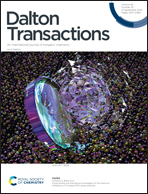Effecting structural diversity in a series of Co(ii)–organic frameworks by the interplay between rigidity of a dicarboxylate and flexibility of bis(tridentate) spanning ligands†
Abstract
In a one-pot self-assembly reaction of Co(OAc)2·4H2O, thiophene-2,5-dicarboxylic acid (H2tdc) and four different bis(tridentate) polypyridyl spanning ligands under ambient conditions, a series of structurally diverse metal–organic frameworks has been synthesised and characterized by single crystal X-ray diffraction: {[Co2(tdc)2(tpbn)(H2O)2]·solvent}n (solvent = 2H2O, 1; solvent = 2CH3OH, 2H2O, 1a), {[Co2(tdc)2(tphn)]·solvent}n (solvent = H2O, 2; solvent = CH3OH, 2.5H2O, 2a), {[Co2(tdc)2(tpchn)(H2O)2]·solvent}n (solvent = 5H2O, 3; solvent = C2H5OH, 2H2O, 3a), and {[Co2(tdc)2(tpxn)]·solvent}n (solvent = 6H2O, 4; when no solvent, 4a), where tpbn (N,N′,N′′,N′′′-tetrakis(2-pyridylmethyl)-1,4-diaminobutane), tphn = N,N′,N′′,N′′′-tetrakis(2-pyridylmethyl)-1,6-diaminohexane, tpchn = N,N′-(cyclohexane-1,4-diylbis(methylene))bis(1-(pyridin-2-yl)-N-(pyridin-2-ylmethyl)methanamine) and tpxn = N,N′-(1,4-phenylenebis(methylene))bis(1-(pyridin-2-yl)-N-(pyridin-2-ylmethyl)methanamine). There is a profound effect of the nature of spacer between the alkyl nitrogens in the spanning ligands (flexible vs. semiflexible) on the molecular structures of 1a–4a. The notable differences are (a) the binding mode of the tridentate part of polypyridyl ligands to the Co(II) center is facial in 1a, 3a and 4a but meridional in 2a, (b) the Co(II) centers in 1a–3a are hexacoordinated (with a coordinated water in 1a and 3a) but are pentacoordinated in 4a, and (c) the binding mode of tdc linker is bis(monodentate) in 1a, 3a and 4a but chelated in one end and monodentate in the other end in 2a. Thus, the overall framework structure of 1a, 2a, 3a and 4a is cis-decalin type 2D polymer, ladder-shaped 1D polymer, hexagonal 2D net and cis-decalin type 2D polymer, respectively. Their thermal stabilities have been established by thermogravimetric analysis (TGA). The presence of an unsaturated metal center in 4 has provided us an opportunity for its use as an efficient Lewis acid catalyst for the Knoevenagel condensation reaction of malononitrile with various aldehydes (100% conversion in 60 minutes with 2 mol% catalyst in methanol).



 Please wait while we load your content...
Please wait while we load your content...